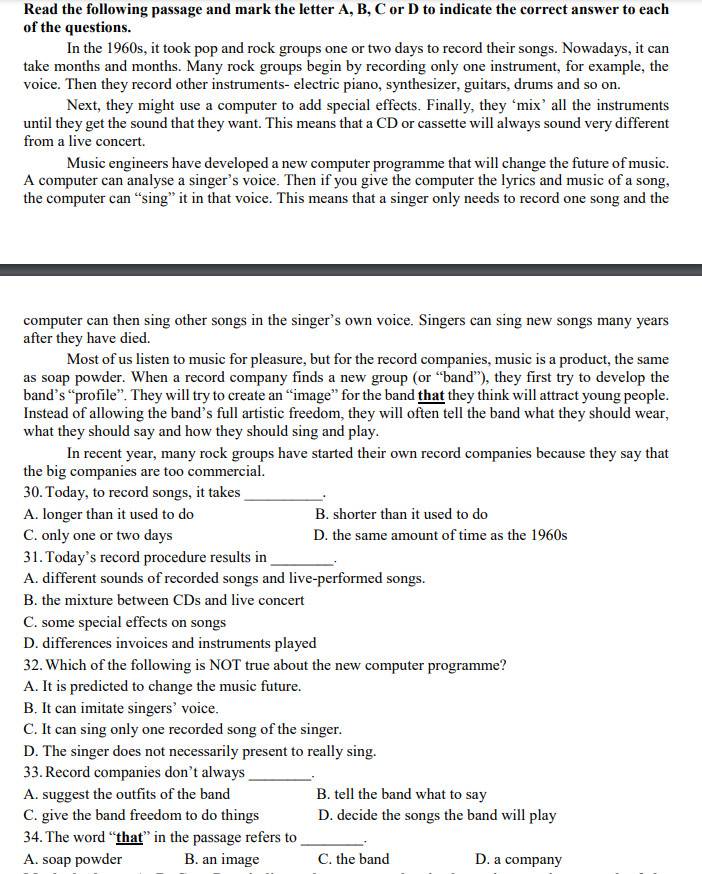 Mọi người làm giúp mình bài này với ạ, mình cảm ơn!
Mọi người làm giúp mình bài này với ạ, mình cảm ơn!
Hãy nhập câu hỏi của bạn vào đây, nếu là tài khoản VIP, bạn sẽ được ưu tiên trả lời.


1) Áp dụng định lí Pytago vào ΔABC vuông tại A, ta được:
\(BC^2=AB^2+AC^2\)
\(\Leftrightarrow BC^2=6^2+8^2=100\)
hay BC=10(cm)
Áp dụng hệ thức lượng trong tam giác vuông vào ΔABC vuông tại A có AH là đường cao ứng với cạnh huyền BC, ta được:
\(AH\cdot BC=AB\cdot AC\)
\(\Leftrightarrow AH\cdot10=6\cdot8=48\)
hay AH=4,8(cm)

Bài 2:
a) Để hàm số đồng biến thì m+1>0
hay m>-1
b) Để hàm số đi qua điểm A(2;4) thì
Thay x=2 và y=4 vào hàm số, ta được:
\(\left(m+1\right)\cdot2=4\)
\(\Leftrightarrow m+1=2\)
hay m=1
c) Để hàm số đi qua điểm B(2;-4) thì
Thay x=2 và y=-4 vào hàm số, ta được:
\(2\left(m+1\right)=-4\)
\(\Leftrightarrow m+1=-2\)
hay m=-3
Bài 1:
b) Ta có: \(5\cdot\sqrt{25a^2}-25a\)
\(=5\cdot5\cdot\left|a\right|-25a\)
\(=-25a-25a=-50a\)

Mặt cầu tâm \(I\left(1;1;0\right)\) bán kính \(R=5\)
\(\Rightarrow IA=\sqrt{6^2+8^2}=10=2R\)
Gọi C là trung điểm IA \(\Rightarrow C\left(4;5;0\right)\Rightarrow IC=R=5\Rightarrow C\in\left(S\right)\)
Gọi D là trung điểm IC \(\Rightarrow D\left(\dfrac{5}{2};3;0\right)\), đồng thời do D là trung điểm IC \(\Rightarrow MD\perp IC\) và IM=IC=R hay tam giác MDF vuông tại D
Lại có: \(CM=CA=CI=R\Rightarrow\) tam giác AMI vuông tại M
\(\Rightarrow\Delta_VMID\sim\Delta_VAIM\) (chung góc I)
\(\Rightarrow\dfrac{MA}{MD}=\dfrac{AI}{AM}=\dfrac{2R}{R}=2\Rightarrow MA=2MD\)
\(\Rightarrow P=MA+2MB=2MD+2MB=2\left(MD+MB\right)\ge2DB=2\sqrt{\left(\dfrac{5}{2}\right)^2+\left(3-8\right)^2+0^2}=5\sqrt{5}\)

30.today, to record songs, it takes __________.
A. longer than it used to do
B. shorter than it used to do
C. only one or two days
D. the same amount of time as the 1960s
31.Today’s record procedure results in ________.
A. different sounds of recorded songs and live- performed songs.
B. the mixture between CDs and live concert
C. some special effects on songs
D. differences invoices and instruments played
32. Which of the following is NOT true about the new computer programme?
A. It is predicted to change the music future.
B. It can imitate singers‟ voice.
C. It can sing only one recorded song of the singer.
D. The singer does not necessarily present to really sing.
33.Record companies don’t always ________.
A. suggest the outfits of the band
B. tell the band what to say
C. give the band freedom to do things
D. decide the songs the band will play
34.The word “that” in the passage refers to ________.
A. soap powder
B. an image
C. the band
D. a company

Bài 2:
a: =>168x+20=6x-21
=>162x=-41
hay x=-41/162
b: \(\Leftrightarrow2\left(3x-8\right)=3\left(5-x\right)\)
=>6x-16=15-3x
=>9x=31
hay x=31/9
c: \(\Leftrightarrow4\left(x^2+8x-20\right)-\left(x+4\right)\left(x+10\right)=3\left(x^2+2x-8\right)\)
\(\Leftrightarrow4x^2+32x-80-x^2-14x-40-3x^2-6x+24=0\)
=>12x-96=0
hay x=8


a) (d) cắt trục hoành tại điểm có hoành độ bằng 2
\(\Rightarrow\) tọa độ điểm đó là \(\left(2;0\right)\)
\(\Rightarrow0=2a-3\Rightarrow a=\dfrac{3}{2}\Rightarrow\left(d\right):y=\dfrac{3}{2}x-3\)
b) Vì (d) song song với đồ thị của hàm \(y=2x+1\)
\(\Rightarrow\left\{{}\begin{matrix}a=2\\-3\ne1\end{matrix}\right.\Rightarrow a=2\Rightarrow\left(d\right):y=2x-3\)
c) Gọi A là giao điểm của (d) và (d')
\(\Rightarrow x_A=1\Rightarrow y_A=2+3=5\Rightarrow A\left(1;5\right)\)
\(\Rightarrow5=a-3\Rightarrow a=8\Rightarrow\left(d\right):y=8x-3\)

a) Thay a=3 vào (d), ta được:
y=3x+b
Vì (d): y=3x+b cắt trục hoành tại điểm có hoành độ bằng 2 nên
Thay x=2 và y=0 vào (d), ta được:
\(3\cdot2+b=0\)
\(\Leftrightarrow b=-6\)
Vậy: (d): y=3x-6
b) Thay a=2 vào (d), ta được:
y=2x+b
Thay x=1 và y=6 vào (d), ta được:
\(b+2\cdot1=6\)
hay b=4
Vậy: (d): y=2x+4










a: Xét ΔABC vuông tại A và ΔHAC vuông tại H có
\(\widehat{HCA}\) chung
Do đó: ΔABC~ΔHAC
b: ΔABC vuông tại A
=>\(AB^2+AC^2=BC^2\)
=>\(BC=\sqrt{8^2+15^2}=17\left(cm\right)\)
ΔABC~ΔHAC
=>\(\dfrac{AB}{HA}=\dfrac{BC}{AC}\)
=>\(AH=\dfrac{AB\cdot AC}{BC}=\dfrac{120}{17}\left(cm\right)\)
c: Xét ΔBAF vuông tại A và ΔBHE vuông tại H có
\(\widehat{ABF}=\widehat{HBE}\)
Do đó: ΔBAF~ΔBHE
d: ΔBAF~ΔBHE
=>\(\widehat{BFA}=\widehat{BEH}\)
mà \(\widehat{BEH}=\widehat{AEF}\)(hai góc đối đỉnh)
nên \(\widehat{AEF}=\widehat{AFE}\)
=>ΔAEF cân tại A
e: Xét ΔBAH có BE là phân giác
nên \(\dfrac{AE}{EH}=\dfrac{BA}{BH}\left(1\right)\)
Xét ΔBAC có BF là phân giác
nên \(\dfrac{FC}{FA}=\dfrac{BC}{BA}\left(2\right)\)
Xét ΔBHA vuông tại H và ΔBAC vuông tại A có
\(\widehat{HBA}\) chung
Do đó: ΔBHA~ΔBAC
=>\(\dfrac{BA}{BC}=\dfrac{BH}{BA}\)
=>\(\dfrac{BC}{BA}=\dfrac{BA}{BH}\left(3\right)\)
Từ (1),(2),(3) suy ra \(\dfrac{AE}{EH}=\dfrac{FC}{FA}\)
=>\(AE\cdot FA=FC\cdot EH\)